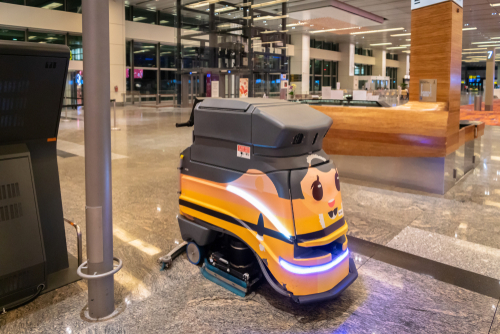Robots have been useful in taking on dangerous tasks and replacing humans in hazardous situations and unsanitary environments. Moreover, robots have slowly but steadily entered the commercial buildings space, supporting humans by taking on repetitive and tedious tasks.

That’s according to a new report from Guidehouse Insights. The report explores the market for robots in commercial buildings, including market drivers, barriers, and trends for each application, and examines global market forecasts for revenue, by segment and region, through 2030.
Though the market for robots in commercial buildings is still nascent, the report says robots have demonstrated their value by automating operational processes in several key commercial building verticals, namely in retail, restaurants, healthcare facilities, and airports.
The report says key market drivers include the need to sterilize spaces to reduce virus infection risks, shorten goods delivery times, reduce labor costs, and free employees from menial tasks so they can concentrate on higher-value activities.
According to the report, annual market revenue for commercial building robots is estimated to reach $11 billion by 2030, growing at a compound annual growth rate (CAGR) of 29%.
“Although COVID-19 has had an overall positive impact on market growth because of social distancing and preferences for clean and sterilized spaces, the pandemic has not driven sales for all robot solutions,” says Young Hoon Kim, research analyst with Guidehouse Insights.
“Disinfection, floor cleaning, and serving robots have gained market traction, but the parking and hotel delivery robot business has suffered due to significantly reduced transit and travel.”
In addition, the report says the market still faces barriers such as legal hurdles that need to be overcome. For instance, if a security robot confronts an intruder and uses force, the legal ramifications of such a situation need to be outlined. Similarly, the report says a serving robot that collides with a customer in a restaurant could create significant legal issues that need thorough vetting.
According to the report, other market barriers include limited human activity replication, high product prices, lack of customer awareness, and public safety concerns that need to be addressed.
Nevertheless, the report notes the rise of robot deployments for numerous use cases—from floor cleaning and disinfection robots to retail shelf management robots, serving robots, and building service robots—can be attributed to many technology improvements in areas such as distance measurement sensing, machine learning, and cloud computing.
The full Guidehouse Insights report, Robots for Commercial Buildings, is available here.
